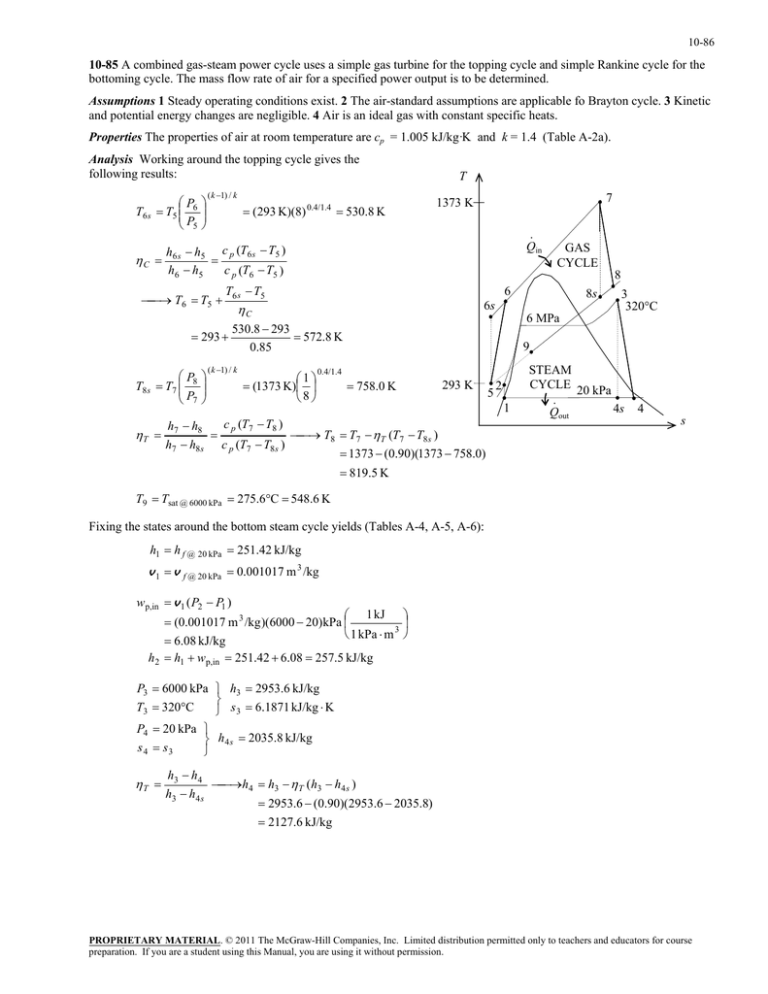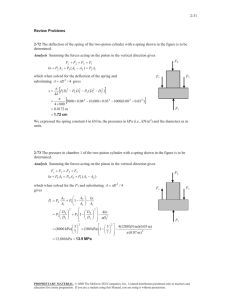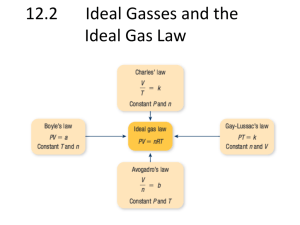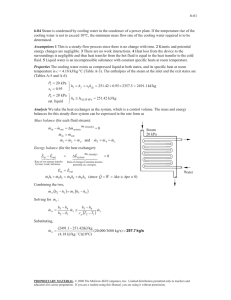bottoming cycle. The mass flow rate of air for a... 4 k
advertisement

10-86 10-85 A combined gas-steam power cycle uses a simple gas turbine for the topping cycle and simple Rankine cycle for the bottoming cycle. The mass flow rate of air for a specified power output is to be determined. Assumptions 1 Steady operating conditions exist. 2 The air-standard assumptions are applicable fo Brayton cycle. 3 Kinetic and potential energy changes are negligible. 4 Air is an ideal gas with constant specific heats. Properties The properties of air at room temperature are cp = 1.005 kJ/kg·K and k = 1.4 (Table A-2a). Analysis Working around the topping cycle gives the following results: T6 s P T5 6 P5 ( k 1) / k (293 K)(8) 0.4/1.4 530.8 K T 7 1373 K · Qin c p (T6 s T5 ) h h C 6s 5 h6 h5 c p (T6 T5 ) T6 T5 8 T6 s T5 6 C ( k 1) / k 8s 6s 1 (1373 K) 8 3 320C 6 MPa 530.8 293 293 572.8 K 0.85 P T8 s T7 8 P7 GAS CYCLE 9 0.4/1.4 758.0 K 293 K c p (T7 T8 ) h h T8 T7 T (T7 T8 s ) T 7 8 h7 h8 s c p (T7 T8 s ) 1373 (0.90)(1373 758.0) 819.5 K 5 2 1 STEAM CYCLE 20 kPa · 4s Qout 4 s T9 Tsat @ 6000 kPa 275.6C 548.6 K Fixing the states around the bottom steam cycle yields (Tables A-4, A-5, A-6): h1 h f @ 20 kPa 251.42 kJ/kg v 1 v f @ 20 kPa 0.001017 m 3 /kg wp,in v 1 ( P2 P1 ) 1 kJ (0.001017 m 3 /kg )(6000 20)kPa 1 kPa m 3 6.08 kJ/kg h2 h1 wp,in 251.42 6.08 257.5 kJ/kg P3 6000 kPa h3 2953.6 kJ/kg s 3 6.1871 kJ/kg K P4 20 kPa h4 s 2035.8 kJ/kg s 4 s3 T3 320C T h3 h4 h4 h3 T (h3 h4 s ) h3 h4 s 2953.6 (0.90)(2953.6 2035.8) 2127.6 kJ/kg PROPRIETARY MATERIAL. © 2011 The McGraw-Hill Companies, Inc. Limited distribution permitted only to teachers and educators for course preparation. If you are a student using this Manual, you are using it without permission. 10-87 The net work outputs from each cycle are wnet, gas cycle wT, out wC,in c p (T7 T8 ) c p (T6 T5 ) (1.005 kJ/kg K )(1373 819.5 572.7 293)K 275.2 kJ/kg wnet, steam cycle wT,out wP,in (h3 h4 ) wP,in (2953.6 2127.6) 6.08 819.9 kJ/kg An energy balance on the heat exchanger gives m a c p (T8 T9 ) m w (h3 -h2 ) m w c p (T8 T9 ) h3 -h2 m a (1.005)(819.5 548.6) 0.1010m a 2953.6 257.5 That is, 1 kg of exhaust gases can heat only 0.1010 kg of water. Then, the mass flow rate of air is m a W net 100,000 kJ/s 279.3 kg/s wnet (1 275.2 0.1010 819.9) kJ/kg air PROPRIETARY MATERIAL. © 2011 The McGraw-Hill Companies, Inc. Limited distribution permitted only to teachers and educators for course preparation. If you are a student using this Manual, you are using it without permission.







